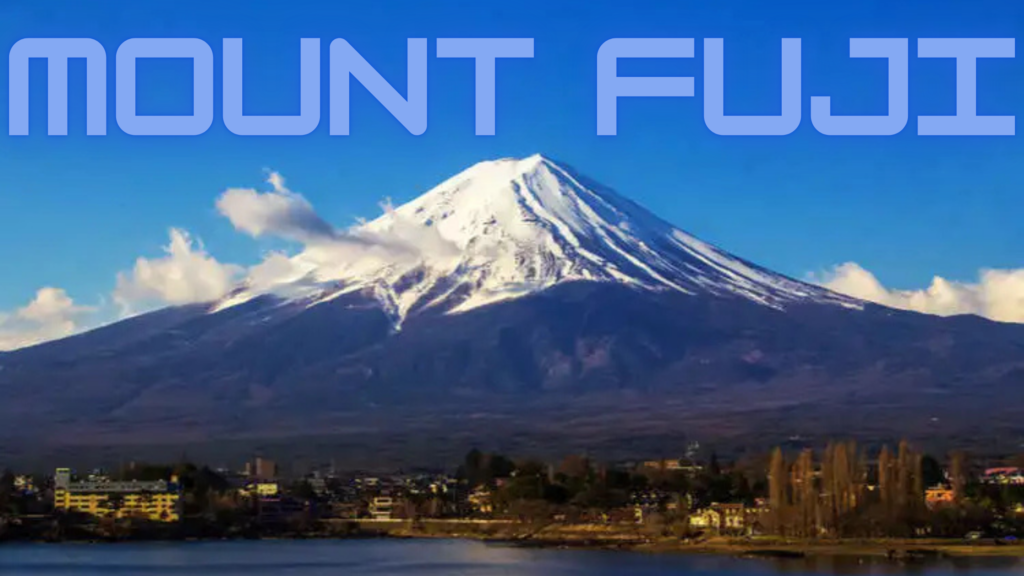Mount Fuji (富士山, Fujisan) is Japan’s highest mountain at 3776 meters. It is hardly unexpected that the nearly flawlessly sculpted volcano has been revered as a sacred mountain and enjoyed widespread popularity among artists and ordinary people over the years.
Mount Fuji is an active volcano, with the most recent eruption in 1707. It is located on the boundary of Yamanashi and Shizuoka prefectures and can be viewed from Tokyo and Yokohama on clear days.
Another easy method to see Mount Fuji is from the train between Tokyo and Osaka. If you travel the shinkansen from Tokyo to Nagoya, Kyoto, or Osaka, the best view of the mountain is around Shin-Fuji Station on the train’s right side, around 40-45 minutes into the journey.
Note, however, that clouds and low visibility frequently obscure the view of Mount Fuji, and you should consider yourself fortunate if you get a clean view of the peak. Visibility is often better during the cooler months of the year than during the summer, especially in the early morning and late evening hours than in the middle of the day.
If you wish to explore Mount Fuji at a slower pace and in a beautiful natural setting, come to the Fuji Five Lake (Fujigoko) region at the mountain’s northern foot, or to Hakone, a nearby hot spring resort. Mount Fuji is officially available for climbing in July and August, with many routes.

Climb Mount Fuji
Climbing Mount Fuji is an unforgettable experience, and planning ahead for 2025 will make sure you’re well-prepared for a smooth trip. Here’s a complete guide for your climb:
Climbing Season
- Official Season: Typically, from early July to early September, when trails and facilities are open and weather is at its safest.
- Weather: Prepare for unpredictable mountain weather, with temperatures dropping near freezing at the summit even in summer.
Tour Options
- Guided Tours: Ideal for first-timers, especially if you require assistance with pacing, lodgings, and insights into local culture. Some excursions provide English-speaking guides, meal packages, and planned stays in mountain lodges.
- Self-Guided Climb: Independent climbers can book mountain huts, but early reservations are advised, as these fill up quickly.
Your Choice : Gulhi Beach, Gulhi Island, Maldives | All things to Know | 2025
White Coral Rasdhoo, Maldives | Photos & Guide | 2025
Is it worth it to stay in Mount Fuji?
Staying on Mount Fuji can be a memorable experience, especially if you plan to catch the sunrise or want to take your time climbing to the summit. Here are some factors to consider:
Watching the sunrise from the summit or higher stations is a highlight of the climb and offers unparalleled views. It’s a spiritual and picturesque experience that many people claim makes the journey unforgettable.
If you want to thoroughly enjoy Mount Fuji without rushing, staying overnight is well worth it. The quiet setting, cultural experience, and opportunity to see the sunrise from above the clouds all contribute to its attractiveness. However, if you have limited time or want a more strenuous climb, you can do the round trip without staying overnight.
Best day of the week to visit mt fuji
Weekdays, particularly Tuesday through Thursday, are ideal for visiting Mt. Fuji since there are fewer tourists, making for a more relaxing experience. Weekends, particularly Saturday and Sunday, see greater footfall, resulting in longer waits and a busier atmosphere.
What is the best time of day to see Mount Fuji?
If seeing Mount Fuji is one of your main goals when visiting Japan, plan your travel dates around December and January to get the best views of the mountain and its peak unobstructed by clouds. The best time of the day to spot the mountain is early morning between 7.00am to 10.00am, so be sure to set that alarm clock!
Is December a good time to visit Mt. Fuji?
Although Mount Fuji is unquestionably beautiful all year, the colder months, notably November to February, add an added layer of mystique. Visiting Mount Fuji in the winter adds a unique dimension to your experience, providing a one-of-a-kind perspective of Japan’s famed peak.
In Conclusion
The sunrise from the peak is an iconic reward for early risers, and staying in mountain huts provides additional comfort and altitude adjustment. Remember to dress for variable conditions and bring necessary equipment to guarantee a safe ascent. Taking it slowly and staying hydrated will help you prevent altitude sickness while also enjoying the adventure. This trek is about more than simply reaching the summit; it’s about enjoying every step of the journey. Embrace the spirit of goraiko, which welcomes the new day from Japan’s most sacred mountain.



Pingback: Things To Do Orlando Florida | Top 10 unique Places Visit! - Flyadvice